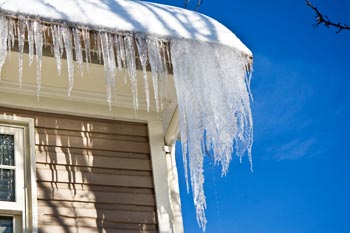In Business Since | License #
In Business Since | License #


Ice dam damage. Snow that melts in upper areas of the
roof freezes at the eaves, forming icicles, filling gutters with ice and creating a ridge or dam that can channel melt-water into the attic and living space.
Ice damming can cause problems like water leaking into the attic, which could soak the wood, insulation, flooring, or upstairs ceiling, and even possibly the valuables stored in the attic. It can also ruin rain gutters.
Dr. Energy Saver can prevent this from happening by sealing air leaks where heat escapes into the attic and improving the attic insulation coverage. If your home is experiencing ice dams, call us for a Free Inspection and Estimate to prevent ice dams in the future.
If you’ve spent any time in snow country, you’ve heard about ice dams and the damage they can cause to a house. When snow has had a chance to accumulate on the roof, it just takes a day or two for those tell-tale icicles to form at the roof edge. Once this happens, water often seeps into the attic, then proceeds to soak attic and wall insulation and even interior ceiling and wall surfaces. Outside the house, ice accumulation can ruin gutters and even pose a safety hazard.
Homeowners are distressed to discover that a “perfectly good” house can suddenly sustain hundreds or even thousands of dollars worth of damage. The good news is that the damage from ice dams can be prevented and Dr. Energy Saver is here to help.
But before we get to the cure, let’s gain a better understanding of how this problem occurs. Snow accumulation on the roof is the first step, and the deeper the snow, the more severe the problem is likely to be. Heat that leaks into the attic from the living space below warms the roof surface, and causes snow to melt. Melting doesn’t happen evenly or uniformly, because some parts of the roof will be warmer than others. For example, if there’s an attic hatch or drop-down stair that hasn’t been well sealed or insulated, lots of warm air will leak up in this area, causing more snow to melt on the roof surface immediately above the opening.
The roof will always be coldest along its edge because this part of the roof projects beyond the exterior walls, where heat from the house isn’t available. In fact, the roof edge is where the melt-water freezes and forms an ice dam. Sometimes water freezes in the gutters, filling the gutters with ice. In other situations, the water freezes right at the edge of the roof, before it reaches the gutters. Either way, the resulting ridge of ice forms a dam that creates a reservoir of water. When this happens, it’s only a matter of time before the water seeps beneath roof shingles and leaks into the attic.
Rule #1: Keep the roof cold. How can ice dams be prevented? The simple answer is to keep the roof surface cold so that snow won’t melt on upper roof areas and freeze at the eaves. Ideally, the entire roof should be thermally isolated from the home’s living space, so that roof temperature is more uniform from eave to ridge. The temperature of the entire roof should be dependent on exterior temperature, not on heat that leaks into the attic from the living space.
Rule #2: The best way to achieve Rule #1 is by air-sealing and insulating the attic. Most houses have inadequate attic insulation and an abundance of air leaks that allow conditioned air from the living space to escape into the attic. Ice dams on a house are a sure sign of air leakage and low insulation levels. To solve this problem, it’s necessary to eliminate “communication” between the living space and the roof surface. You can do this by having the attic air-sealed by skilled professionals and having new insulation installed to recommended levels. Air leaks between the living space and the attic can be difficult to find and seal. That’s why it’s important to have this work done by experienced workers like the pros at Dr. Energy Saver. Investing in these attic upgrades will enable you to stop worrying about ice dams while also enjoying significant energy savings.
Call or contact us online for a Free Ice Dam Prevention Inspection and Estimate.
Looking for a price? Get a no cost, no obligation free estimate.